Environmental Criminology: Evaluating International Agreement Impact
VerifiedAdded on 2021/02/21
|10
|2598
|186
Essay
AI Summary
This essay delves into the field of environmental criminology, specifically examining the role and effectiveness of international agreements in mitigating various environmental crimes. It begins by defining environmental criminology and highlighting the involvement of international bodies like the United Nations in regulating such crimes. The essay then explores the different types of environmental crimes, including trafficking of wild animals, indiscriminate logging, electronic waste management, finning, and dumping of pollutants, detailing their impacts and the criminal activities involved. It further analyzes the efforts of organizations like UNICRI in combating environmental crime through research, capacity building, and networking. The essay also discusses the challenges in enforcing environmental laws, including weak penalties, organized criminal groups, and the need for stronger enforcement mechanisms. Finally, it assesses the impact of international agreements, such as those related to waste disposal and wildlife trafficking, highlighting both their successes and limitations in reducing environmental harm and promoting sustainability. The analysis includes discussion on enforcement agencies and compliance methods.
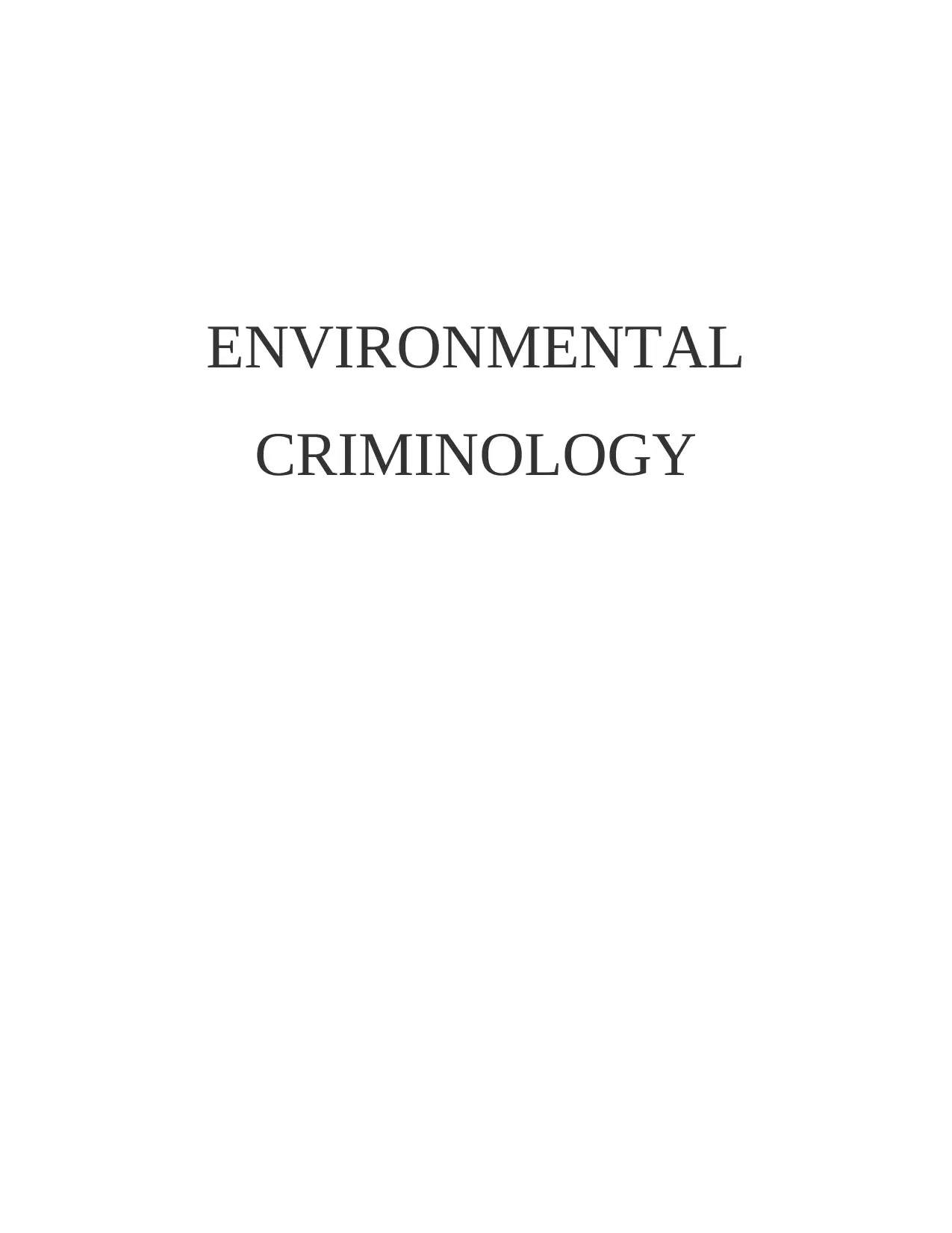
ENVIRONMENTAL
CRIMINOLOGY
CRIMINOLOGY
Paraphrase This Document
Need a fresh take? Get an instant paraphrase of this document with our AI Paraphraser

TABLE OF CONTENTS
ENVIRONMENT CRIMINOLOGY...............................................................................................1
REFERENCES................................................................................................................................7
ENVIRONMENT CRIMINOLOGY...............................................................................................1
REFERENCES................................................................................................................................7
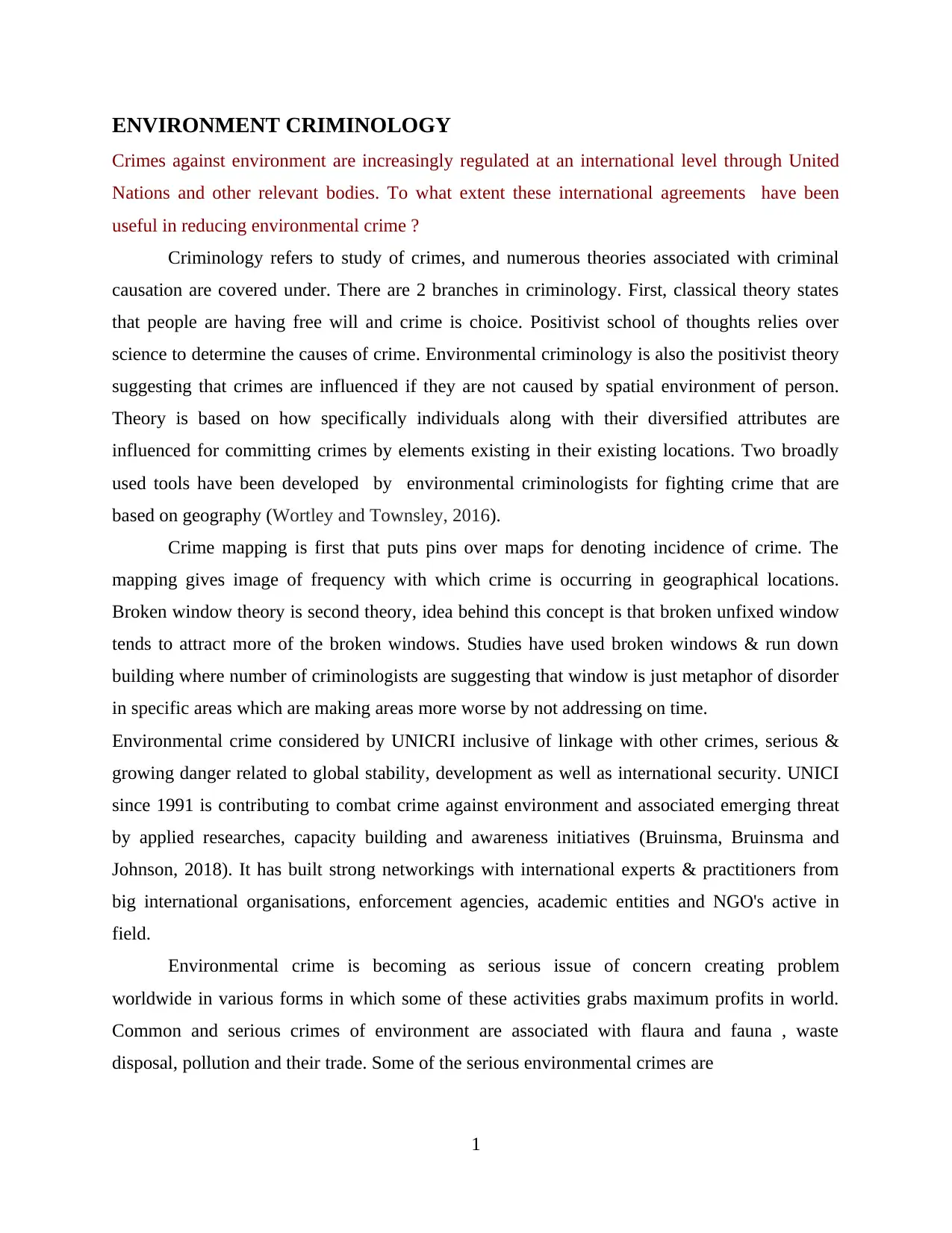
ENVIRONMENT CRIMINOLOGY
Crimes against environment are increasingly regulated at an international level through United
Nations and other relevant bodies. To what extent these international agreements have been
useful in reducing environmental crime ?
Criminology refers to study of crimes, and numerous theories associated with criminal
causation are covered under. There are 2 branches in criminology. First, classical theory states
that people are having free will and crime is choice. Positivist school of thoughts relies over
science to determine the causes of crime. Environmental criminology is also the positivist theory
suggesting that crimes are influenced if they are not caused by spatial environment of person.
Theory is based on how specifically individuals along with their diversified attributes are
influenced for committing crimes by elements existing in their existing locations. Two broadly
used tools have been developed by environmental criminologists for fighting crime that are
based on geography (Wortley and Townsley, 2016).
Crime mapping is first that puts pins over maps for denoting incidence of crime. The
mapping gives image of frequency with which crime is occurring in geographical locations.
Broken window theory is second theory, idea behind this concept is that broken unfixed window
tends to attract more of the broken windows. Studies have used broken windows & run down
building where number of criminologists are suggesting that window is just metaphor of disorder
in specific areas which are making areas more worse by not addressing on time.
Environmental crime considered by UNICRI inclusive of linkage with other crimes, serious &
growing danger related to global stability, development as well as international security. UNICI
since 1991 is contributing to combat crime against environment and associated emerging threat
by applied researches, capacity building and awareness initiatives (Bruinsma, Bruinsma and
Johnson, 2018). It has built strong networkings with international experts & practitioners from
big international organisations, enforcement agencies, academic entities and NGO's active in
field.
Environmental crime is becoming as serious issue of concern creating problem
worldwide in various forms in which some of these activities grabs maximum profits in world.
Common and serious crimes of environment are associated with flaura and fauna , waste
disposal, pollution and their trade. Some of the serious environmental crimes are
1
Crimes against environment are increasingly regulated at an international level through United
Nations and other relevant bodies. To what extent these international agreements have been
useful in reducing environmental crime ?
Criminology refers to study of crimes, and numerous theories associated with criminal
causation are covered under. There are 2 branches in criminology. First, classical theory states
that people are having free will and crime is choice. Positivist school of thoughts relies over
science to determine the causes of crime. Environmental criminology is also the positivist theory
suggesting that crimes are influenced if they are not caused by spatial environment of person.
Theory is based on how specifically individuals along with their diversified attributes are
influenced for committing crimes by elements existing in their existing locations. Two broadly
used tools have been developed by environmental criminologists for fighting crime that are
based on geography (Wortley and Townsley, 2016).
Crime mapping is first that puts pins over maps for denoting incidence of crime. The
mapping gives image of frequency with which crime is occurring in geographical locations.
Broken window theory is second theory, idea behind this concept is that broken unfixed window
tends to attract more of the broken windows. Studies have used broken windows & run down
building where number of criminologists are suggesting that window is just metaphor of disorder
in specific areas which are making areas more worse by not addressing on time.
Environmental crime considered by UNICRI inclusive of linkage with other crimes, serious &
growing danger related to global stability, development as well as international security. UNICI
since 1991 is contributing to combat crime against environment and associated emerging threat
by applied researches, capacity building and awareness initiatives (Bruinsma, Bruinsma and
Johnson, 2018). It has built strong networkings with international experts & practitioners from
big international organisations, enforcement agencies, academic entities and NGO's active in
field.
Environmental crime is becoming as serious issue of concern creating problem
worldwide in various forms in which some of these activities grabs maximum profits in world.
Common and serious crimes of environment are associated with flaura and fauna , waste
disposal, pollution and their trade. Some of the serious environmental crimes are
1
⊘ This is a preview!⊘
Do you want full access?
Subscribe today to unlock all pages.

Trusted by 1+ million students worldwide
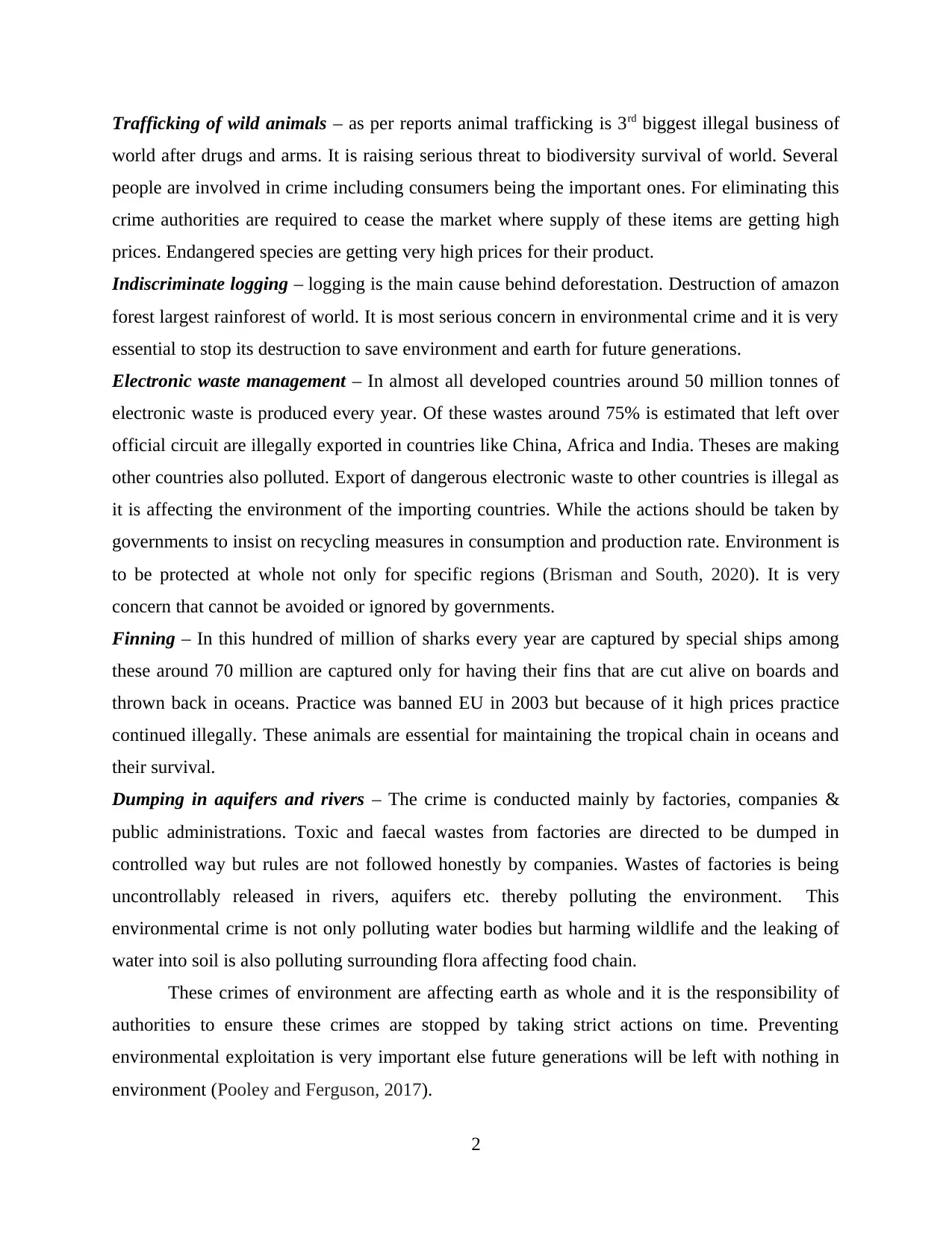
Trafficking of wild animals – as per reports animal trafficking is 3rd biggest illegal business of
world after drugs and arms. It is raising serious threat to biodiversity survival of world. Several
people are involved in crime including consumers being the important ones. For eliminating this
crime authorities are required to cease the market where supply of these items are getting high
prices. Endangered species are getting very high prices for their product.
Indiscriminate logging – logging is the main cause behind deforestation. Destruction of amazon
forest largest rainforest of world. It is most serious concern in environmental crime and it is very
essential to stop its destruction to save environment and earth for future generations.
Electronic waste management – In almost all developed countries around 50 million tonnes of
electronic waste is produced every year. Of these wastes around 75% is estimated that left over
official circuit are illegally exported in countries like China, Africa and India. Theses are making
other countries also polluted. Export of dangerous electronic waste to other countries is illegal as
it is affecting the environment of the importing countries. While the actions should be taken by
governments to insist on recycling measures in consumption and production rate. Environment is
to be protected at whole not only for specific regions (Brisman and South, 2020). It is very
concern that cannot be avoided or ignored by governments.
Finning – In this hundred of million of sharks every year are captured by special ships among
these around 70 million are captured only for having their fins that are cut alive on boards and
thrown back in oceans. Practice was banned EU in 2003 but because of it high prices practice
continued illegally. These animals are essential for maintaining the tropical chain in oceans and
their survival.
Dumping in aquifers and rivers – The crime is conducted mainly by factories, companies &
public administrations. Toxic and faecal wastes from factories are directed to be dumped in
controlled way but rules are not followed honestly by companies. Wastes of factories is being
uncontrollably released in rivers, aquifers etc. thereby polluting the environment. This
environmental crime is not only polluting water bodies but harming wildlife and the leaking of
water into soil is also polluting surrounding flora affecting food chain.
These crimes of environment are affecting earth as whole and it is the responsibility of
authorities to ensure these crimes are stopped by taking strict actions on time. Preventing
environmental exploitation is very important else future generations will be left with nothing in
environment (Pooley and Ferguson, 2017).
2
world after drugs and arms. It is raising serious threat to biodiversity survival of world. Several
people are involved in crime including consumers being the important ones. For eliminating this
crime authorities are required to cease the market where supply of these items are getting high
prices. Endangered species are getting very high prices for their product.
Indiscriminate logging – logging is the main cause behind deforestation. Destruction of amazon
forest largest rainforest of world. It is most serious concern in environmental crime and it is very
essential to stop its destruction to save environment and earth for future generations.
Electronic waste management – In almost all developed countries around 50 million tonnes of
electronic waste is produced every year. Of these wastes around 75% is estimated that left over
official circuit are illegally exported in countries like China, Africa and India. Theses are making
other countries also polluted. Export of dangerous electronic waste to other countries is illegal as
it is affecting the environment of the importing countries. While the actions should be taken by
governments to insist on recycling measures in consumption and production rate. Environment is
to be protected at whole not only for specific regions (Brisman and South, 2020). It is very
concern that cannot be avoided or ignored by governments.
Finning – In this hundred of million of sharks every year are captured by special ships among
these around 70 million are captured only for having their fins that are cut alive on boards and
thrown back in oceans. Practice was banned EU in 2003 but because of it high prices practice
continued illegally. These animals are essential for maintaining the tropical chain in oceans and
their survival.
Dumping in aquifers and rivers – The crime is conducted mainly by factories, companies &
public administrations. Toxic and faecal wastes from factories are directed to be dumped in
controlled way but rules are not followed honestly by companies. Wastes of factories is being
uncontrollably released in rivers, aquifers etc. thereby polluting the environment. This
environmental crime is not only polluting water bodies but harming wildlife and the leaking of
water into soil is also polluting surrounding flora affecting food chain.
These crimes of environment are affecting earth as whole and it is the responsibility of
authorities to ensure these crimes are stopped by taking strict actions on time. Preventing
environmental exploitation is very important else future generations will be left with nothing in
environment (Pooley and Ferguson, 2017).
2
Paraphrase This Document
Need a fresh take? Get an instant paraphrase of this document with our AI Paraphraser
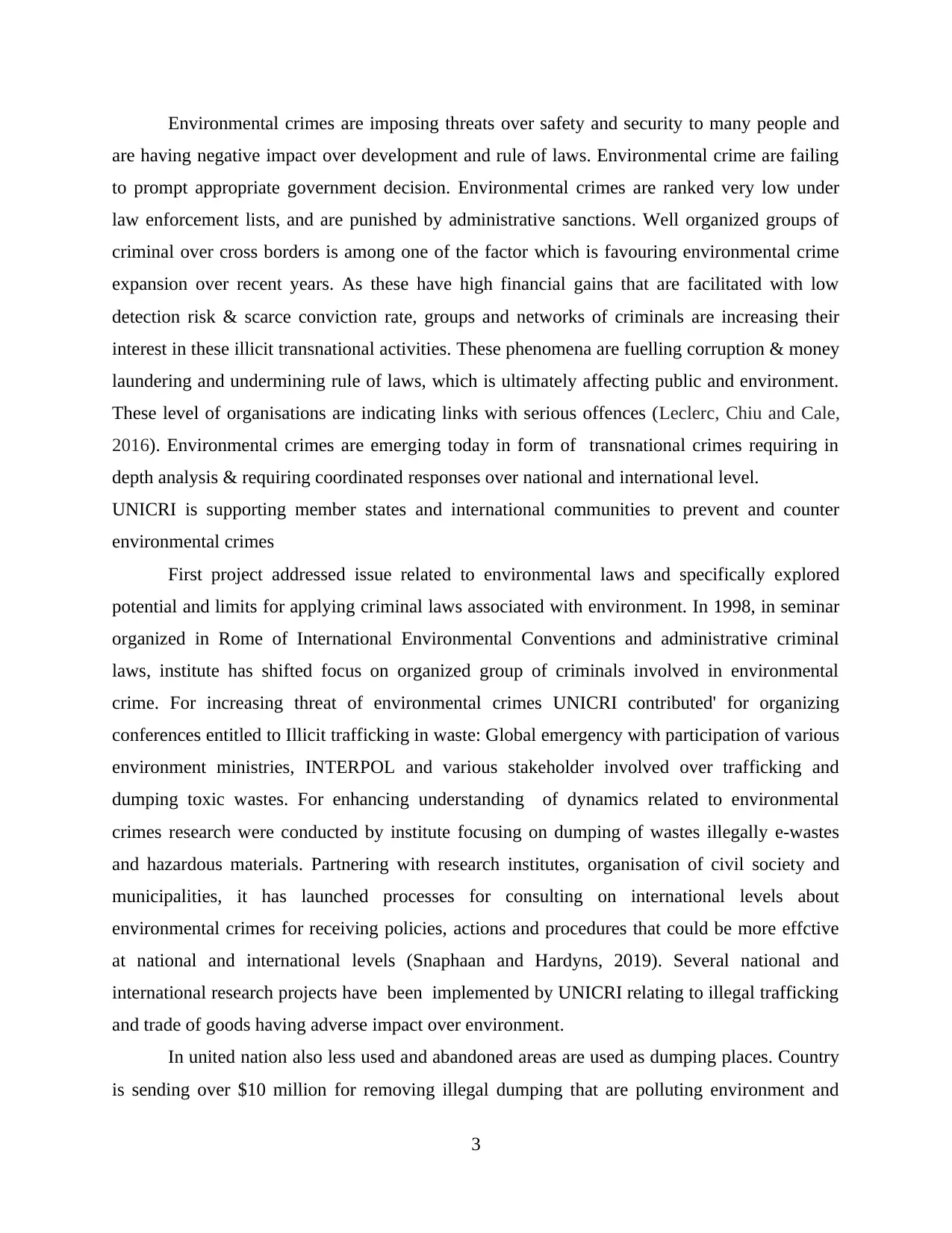
Environmental crimes are imposing threats over safety and security to many people and
are having negative impact over development and rule of laws. Environmental crime are failing
to prompt appropriate government decision. Environmental crimes are ranked very low under
law enforcement lists, and are punished by administrative sanctions. Well organized groups of
criminal over cross borders is among one of the factor which is favouring environmental crime
expansion over recent years. As these have high financial gains that are facilitated with low
detection risk & scarce conviction rate, groups and networks of criminals are increasing their
interest in these illicit transnational activities. These phenomena are fuelling corruption & money
laundering and undermining rule of laws, which is ultimately affecting public and environment.
These level of organisations are indicating links with serious offences (Leclerc, Chiu and Cale,
2016). Environmental crimes are emerging today in form of transnational crimes requiring in
depth analysis & requiring coordinated responses over national and international level.
UNICRI is supporting member states and international communities to prevent and counter
environmental crimes
First project addressed issue related to environmental laws and specifically explored
potential and limits for applying criminal laws associated with environment. In 1998, in seminar
organized in Rome of International Environmental Conventions and administrative criminal
laws, institute has shifted focus on organized group of criminals involved in environmental
crime. For increasing threat of environmental crimes UNICRI contributed' for organizing
conferences entitled to Illicit trafficking in waste: Global emergency with participation of various
environment ministries, INTERPOL and various stakeholder involved over trafficking and
dumping toxic wastes. For enhancing understanding of dynamics related to environmental
crimes research were conducted by institute focusing on dumping of wastes illegally e-wastes
and hazardous materials. Partnering with research institutes, organisation of civil society and
municipalities, it has launched processes for consulting on international levels about
environmental crimes for receiving policies, actions and procedures that could be more effctive
at national and international levels (Snaphaan and Hardyns, 2019). Several national and
international research projects have been implemented by UNICRI relating to illegal trafficking
and trade of goods having adverse impact over environment.
In united nation also less used and abandoned areas are used as dumping places. Country
is sending over $10 million for removing illegal dumping that are polluting environment and
3
are having negative impact over development and rule of laws. Environmental crime are failing
to prompt appropriate government decision. Environmental crimes are ranked very low under
law enforcement lists, and are punished by administrative sanctions. Well organized groups of
criminal over cross borders is among one of the factor which is favouring environmental crime
expansion over recent years. As these have high financial gains that are facilitated with low
detection risk & scarce conviction rate, groups and networks of criminals are increasing their
interest in these illicit transnational activities. These phenomena are fuelling corruption & money
laundering and undermining rule of laws, which is ultimately affecting public and environment.
These level of organisations are indicating links with serious offences (Leclerc, Chiu and Cale,
2016). Environmental crimes are emerging today in form of transnational crimes requiring in
depth analysis & requiring coordinated responses over national and international level.
UNICRI is supporting member states and international communities to prevent and counter
environmental crimes
First project addressed issue related to environmental laws and specifically explored
potential and limits for applying criminal laws associated with environment. In 1998, in seminar
organized in Rome of International Environmental Conventions and administrative criminal
laws, institute has shifted focus on organized group of criminals involved in environmental
crime. For increasing threat of environmental crimes UNICRI contributed' for organizing
conferences entitled to Illicit trafficking in waste: Global emergency with participation of various
environment ministries, INTERPOL and various stakeholder involved over trafficking and
dumping toxic wastes. For enhancing understanding of dynamics related to environmental
crimes research were conducted by institute focusing on dumping of wastes illegally e-wastes
and hazardous materials. Partnering with research institutes, organisation of civil society and
municipalities, it has launched processes for consulting on international levels about
environmental crimes for receiving policies, actions and procedures that could be more effctive
at national and international levels (Snaphaan and Hardyns, 2019). Several national and
international research projects have been implemented by UNICRI relating to illegal trafficking
and trade of goods having adverse impact over environment.
In united nation also less used and abandoned areas are used as dumping places. Country
is sending over $10 million for removing illegal dumping that are polluting environment and
3
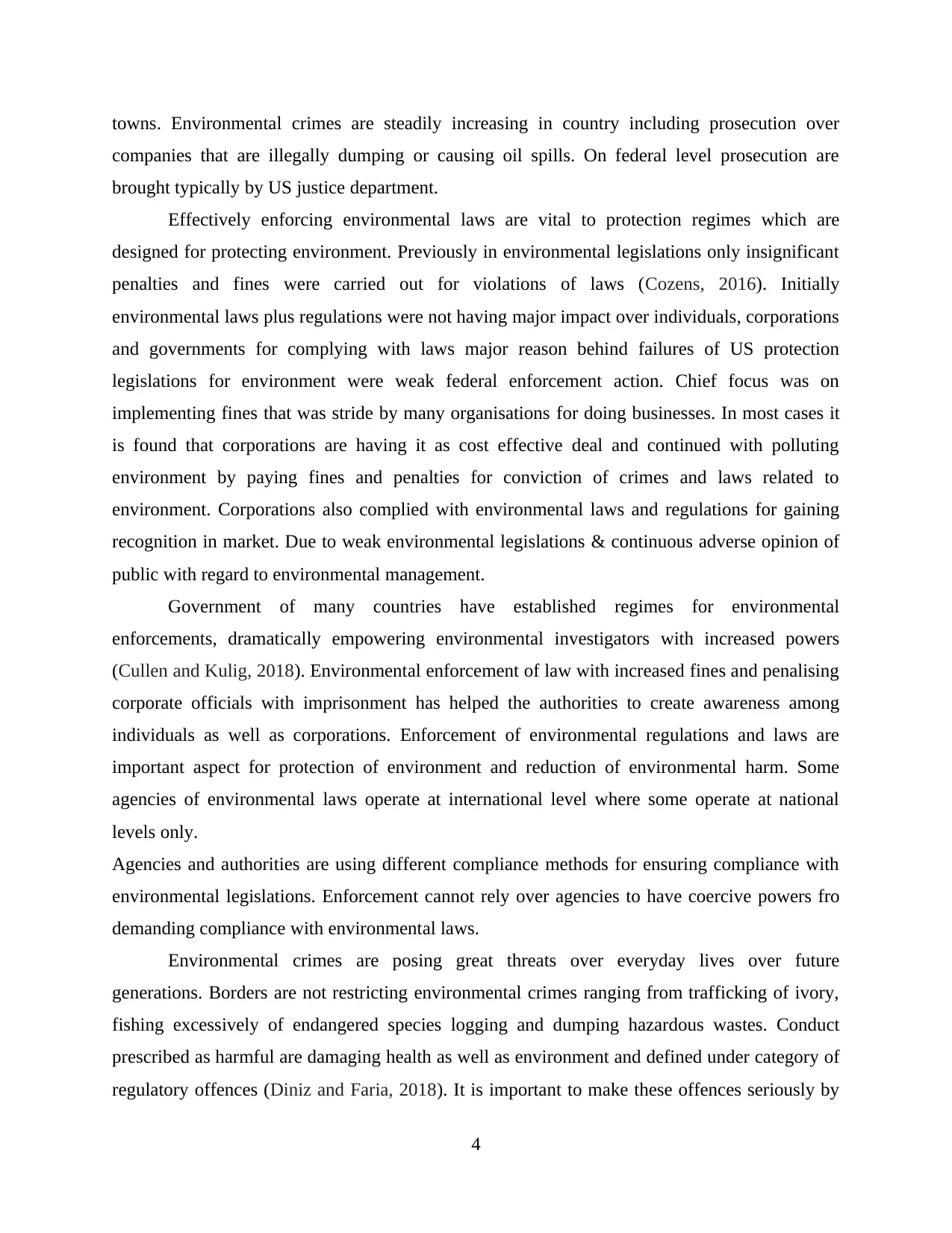
towns. Environmental crimes are steadily increasing in country including prosecution over
companies that are illegally dumping or causing oil spills. On federal level prosecution are
brought typically by US justice department.
Effectively enforcing environmental laws are vital to protection regimes which are
designed for protecting environment. Previously in environmental legislations only insignificant
penalties and fines were carried out for violations of laws (Cozens, 2016). Initially
environmental laws plus regulations were not having major impact over individuals, corporations
and governments for complying with laws major reason behind failures of US protection
legislations for environment were weak federal enforcement action. Chief focus was on
implementing fines that was stride by many organisations for doing businesses. In most cases it
is found that corporations are having it as cost effective deal and continued with polluting
environment by paying fines and penalties for conviction of crimes and laws related to
environment. Corporations also complied with environmental laws and regulations for gaining
recognition in market. Due to weak environmental legislations & continuous adverse opinion of
public with regard to environmental management.
Government of many countries have established regimes for environmental
enforcements, dramatically empowering environmental investigators with increased powers
(Cullen and Kulig, 2018). Environmental enforcement of law with increased fines and penalising
corporate officials with imprisonment has helped the authorities to create awareness among
individuals as well as corporations. Enforcement of environmental regulations and laws are
important aspect for protection of environment and reduction of environmental harm. Some
agencies of environmental laws operate at international level where some operate at national
levels only.
Agencies and authorities are using different compliance methods for ensuring compliance with
environmental legislations. Enforcement cannot rely over agencies to have coercive powers fro
demanding compliance with environmental laws.
Environmental crimes are posing great threats over everyday lives over future
generations. Borders are not restricting environmental crimes ranging from trafficking of ivory,
fishing excessively of endangered species logging and dumping hazardous wastes. Conduct
prescribed as harmful are damaging health as well as environment and defined under category of
regulatory offences (Diniz and Faria, 2018). It is important to make these offences seriously by
4
companies that are illegally dumping or causing oil spills. On federal level prosecution are
brought typically by US justice department.
Effectively enforcing environmental laws are vital to protection regimes which are
designed for protecting environment. Previously in environmental legislations only insignificant
penalties and fines were carried out for violations of laws (Cozens, 2016). Initially
environmental laws plus regulations were not having major impact over individuals, corporations
and governments for complying with laws major reason behind failures of US protection
legislations for environment were weak federal enforcement action. Chief focus was on
implementing fines that was stride by many organisations for doing businesses. In most cases it
is found that corporations are having it as cost effective deal and continued with polluting
environment by paying fines and penalties for conviction of crimes and laws related to
environment. Corporations also complied with environmental laws and regulations for gaining
recognition in market. Due to weak environmental legislations & continuous adverse opinion of
public with regard to environmental management.
Government of many countries have established regimes for environmental
enforcements, dramatically empowering environmental investigators with increased powers
(Cullen and Kulig, 2018). Environmental enforcement of law with increased fines and penalising
corporate officials with imprisonment has helped the authorities to create awareness among
individuals as well as corporations. Enforcement of environmental regulations and laws are
important aspect for protection of environment and reduction of environmental harm. Some
agencies of environmental laws operate at international level where some operate at national
levels only.
Agencies and authorities are using different compliance methods for ensuring compliance with
environmental legislations. Enforcement cannot rely over agencies to have coercive powers fro
demanding compliance with environmental laws.
Environmental crimes are posing great threats over everyday lives over future
generations. Borders are not restricting environmental crimes ranging from trafficking of ivory,
fishing excessively of endangered species logging and dumping hazardous wastes. Conduct
prescribed as harmful are damaging health as well as environment and defined under category of
regulatory offences (Diniz and Faria, 2018). It is important to make these offences seriously by
4
⊘ This is a preview!⊘
Do you want full access?
Subscribe today to unlock all pages.

Trusted by 1+ million students worldwide
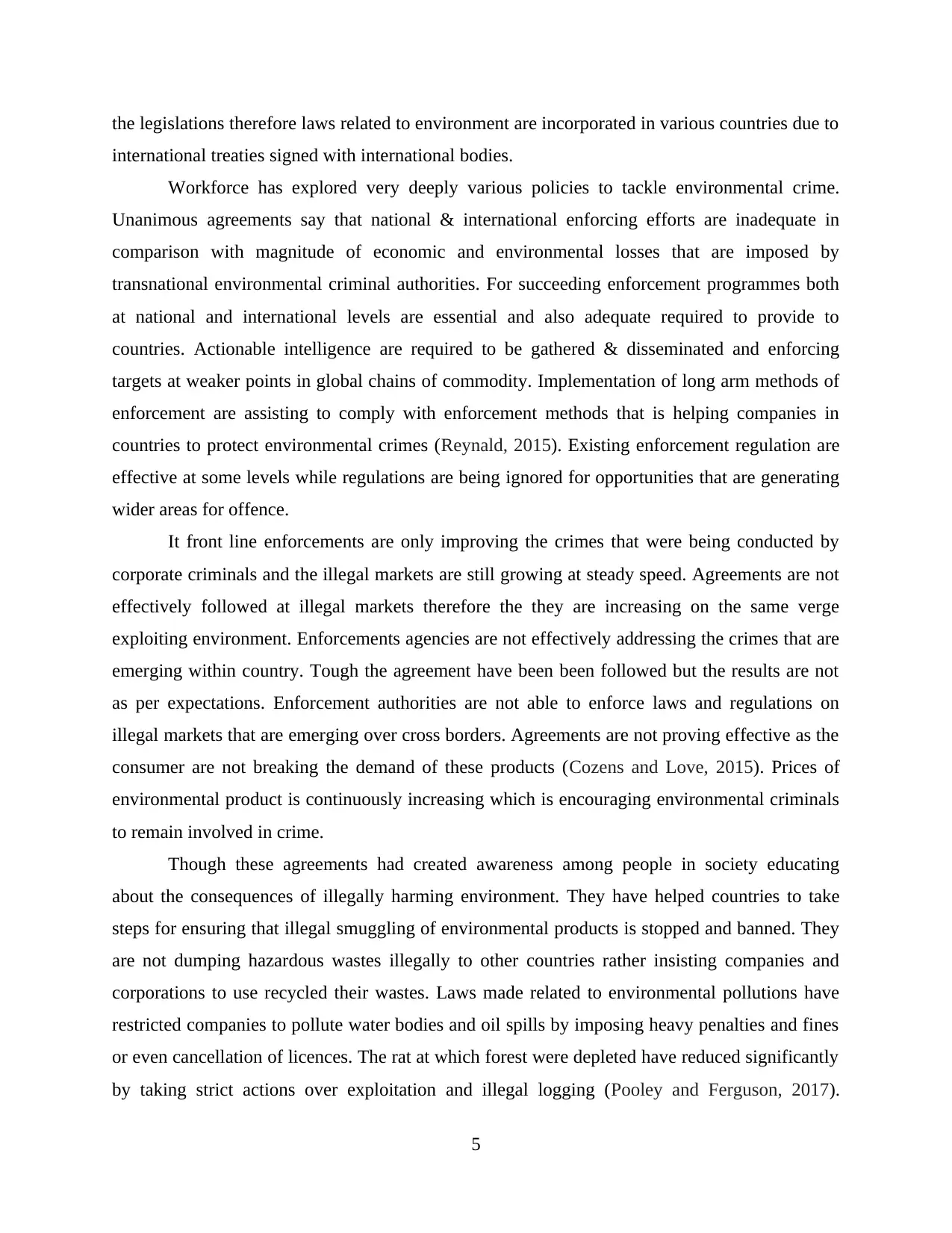
the legislations therefore laws related to environment are incorporated in various countries due to
international treaties signed with international bodies.
Workforce has explored very deeply various policies to tackle environmental crime.
Unanimous agreements say that national & international enforcing efforts are inadequate in
comparison with magnitude of economic and environmental losses that are imposed by
transnational environmental criminal authorities. For succeeding enforcement programmes both
at national and international levels are essential and also adequate required to provide to
countries. Actionable intelligence are required to be gathered & disseminated and enforcing
targets at weaker points in global chains of commodity. Implementation of long arm methods of
enforcement are assisting to comply with enforcement methods that is helping companies in
countries to protect environmental crimes (Reynald, 2015). Existing enforcement regulation are
effective at some levels while regulations are being ignored for opportunities that are generating
wider areas for offence.
It front line enforcements are only improving the crimes that were being conducted by
corporate criminals and the illegal markets are still growing at steady speed. Agreements are not
effectively followed at illegal markets therefore the they are increasing on the same verge
exploiting environment. Enforcements agencies are not effectively addressing the crimes that are
emerging within country. Tough the agreement have been been followed but the results are not
as per expectations. Enforcement authorities are not able to enforce laws and regulations on
illegal markets that are emerging over cross borders. Agreements are not proving effective as the
consumer are not breaking the demand of these products (Cozens and Love, 2015). Prices of
environmental product is continuously increasing which is encouraging environmental criminals
to remain involved in crime.
Though these agreements had created awareness among people in society educating
about the consequences of illegally harming environment. They have helped countries to take
steps for ensuring that illegal smuggling of environmental products is stopped and banned. They
are not dumping hazardous wastes illegally to other countries rather insisting companies and
corporations to use recycled their wastes. Laws made related to environmental pollutions have
restricted companies to pollute water bodies and oil spills by imposing heavy penalties and fines
or even cancellation of licences. The rat at which forest were depleted have reduced significantly
by taking strict actions over exploitation and illegal logging (Pooley and Ferguson, 2017).
5
international treaties signed with international bodies.
Workforce has explored very deeply various policies to tackle environmental crime.
Unanimous agreements say that national & international enforcing efforts are inadequate in
comparison with magnitude of economic and environmental losses that are imposed by
transnational environmental criminal authorities. For succeeding enforcement programmes both
at national and international levels are essential and also adequate required to provide to
countries. Actionable intelligence are required to be gathered & disseminated and enforcing
targets at weaker points in global chains of commodity. Implementation of long arm methods of
enforcement are assisting to comply with enforcement methods that is helping companies in
countries to protect environmental crimes (Reynald, 2015). Existing enforcement regulation are
effective at some levels while regulations are being ignored for opportunities that are generating
wider areas for offence.
It front line enforcements are only improving the crimes that were being conducted by
corporate criminals and the illegal markets are still growing at steady speed. Agreements are not
effectively followed at illegal markets therefore the they are increasing on the same verge
exploiting environment. Enforcements agencies are not effectively addressing the crimes that are
emerging within country. Tough the agreement have been been followed but the results are not
as per expectations. Enforcement authorities are not able to enforce laws and regulations on
illegal markets that are emerging over cross borders. Agreements are not proving effective as the
consumer are not breaking the demand of these products (Cozens and Love, 2015). Prices of
environmental product is continuously increasing which is encouraging environmental criminals
to remain involved in crime.
Though these agreements had created awareness among people in society educating
about the consequences of illegally harming environment. They have helped countries to take
steps for ensuring that illegal smuggling of environmental products is stopped and banned. They
are not dumping hazardous wastes illegally to other countries rather insisting companies and
corporations to use recycled their wastes. Laws made related to environmental pollutions have
restricted companies to pollute water bodies and oil spills by imposing heavy penalties and fines
or even cancellation of licences. The rat at which forest were depleted have reduced significantly
by taking strict actions over exploitation and illegal logging (Pooley and Ferguson, 2017).
5
Paraphrase This Document
Need a fresh take? Get an instant paraphrase of this document with our AI Paraphraser
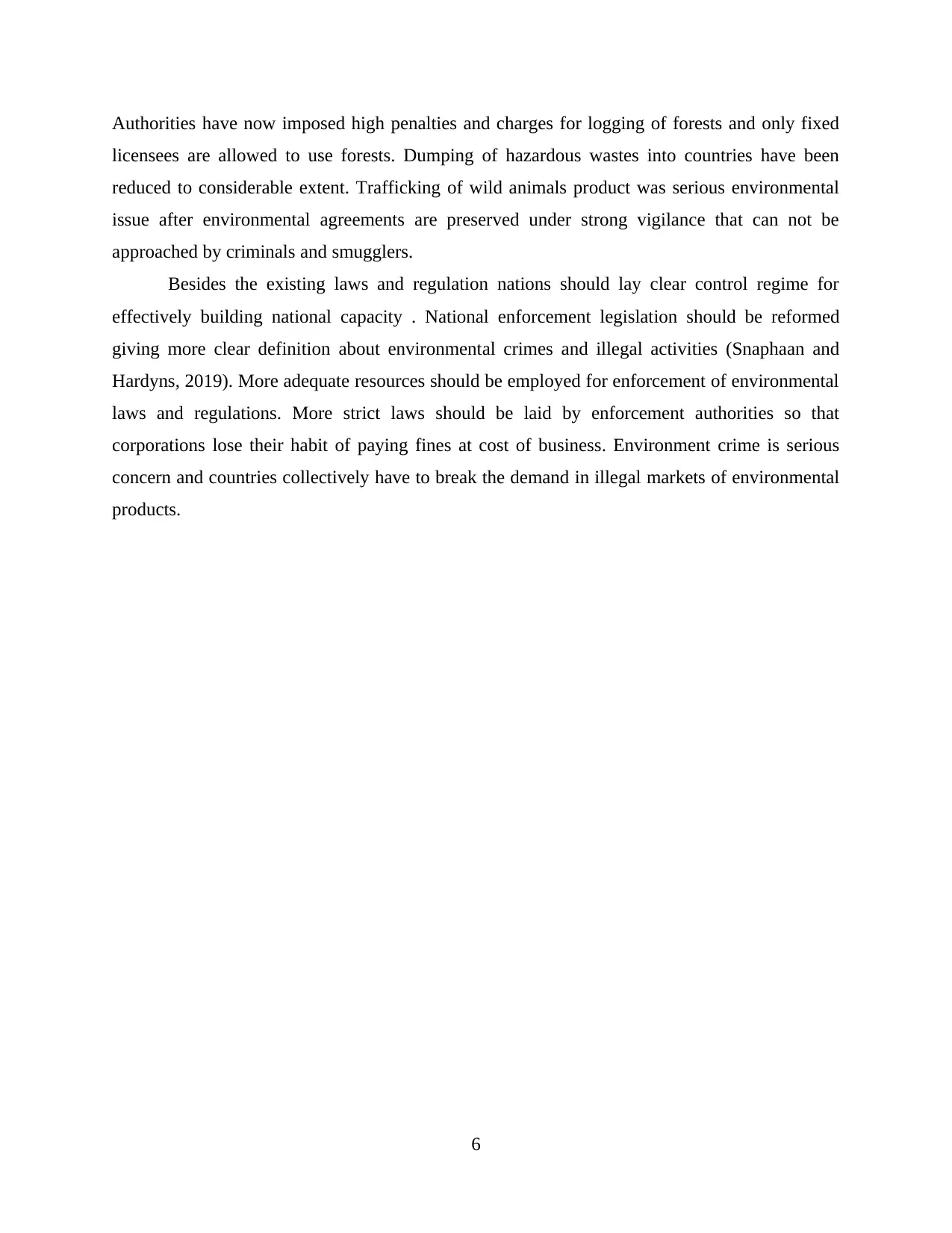
Authorities have now imposed high penalties and charges for logging of forests and only fixed
licensees are allowed to use forests. Dumping of hazardous wastes into countries have been
reduced to considerable extent. Trafficking of wild animals product was serious environmental
issue after environmental agreements are preserved under strong vigilance that can not be
approached by criminals and smugglers.
Besides the existing laws and regulation nations should lay clear control regime for
effectively building national capacity . National enforcement legislation should be reformed
giving more clear definition about environmental crimes and illegal activities (Snaphaan and
Hardyns, 2019). More adequate resources should be employed for enforcement of environmental
laws and regulations. More strict laws should be laid by enforcement authorities so that
corporations lose their habit of paying fines at cost of business. Environment crime is serious
concern and countries collectively have to break the demand in illegal markets of environmental
products.
6
licensees are allowed to use forests. Dumping of hazardous wastes into countries have been
reduced to considerable extent. Trafficking of wild animals product was serious environmental
issue after environmental agreements are preserved under strong vigilance that can not be
approached by criminals and smugglers.
Besides the existing laws and regulation nations should lay clear control regime for
effectively building national capacity . National enforcement legislation should be reformed
giving more clear definition about environmental crimes and illegal activities (Snaphaan and
Hardyns, 2019). More adequate resources should be employed for enforcement of environmental
laws and regulations. More strict laws should be laid by enforcement authorities so that
corporations lose their habit of paying fines at cost of business. Environment crime is serious
concern and countries collectively have to break the demand in illegal markets of environmental
products.
6
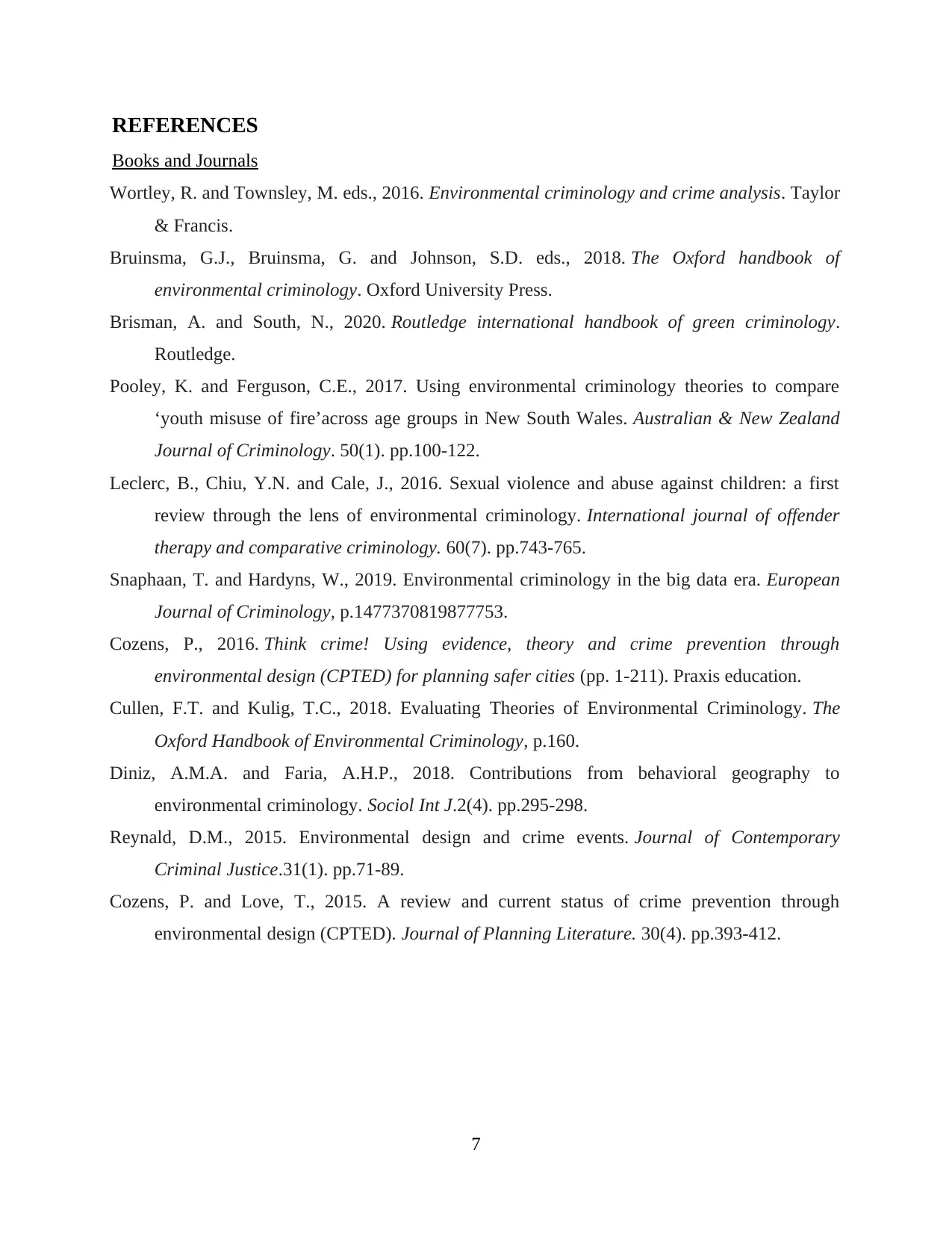
REFERENCES
Books and Journals
Wortley, R. and Townsley, M. eds., 2016. Environmental criminology and crime analysis. Taylor
& Francis.
Bruinsma, G.J., Bruinsma, G. and Johnson, S.D. eds., 2018. The Oxford handbook of
environmental criminology. Oxford University Press.
Brisman, A. and South, N., 2020. Routledge international handbook of green criminology.
Routledge.
Pooley, K. and Ferguson, C.E., 2017. Using environmental criminology theories to compare
‘youth misuse of fire’across age groups in New South Wales. Australian & New Zealand
Journal of Criminology. 50(1). pp.100-122.
Leclerc, B., Chiu, Y.N. and Cale, J., 2016. Sexual violence and abuse against children: a first
review through the lens of environmental criminology. International journal of offender
therapy and comparative criminology. 60(7). pp.743-765.
Snaphaan, T. and Hardyns, W., 2019. Environmental criminology in the big data era. European
Journal of Criminology, p.1477370819877753.
Cozens, P., 2016. Think crime! Using evidence, theory and crime prevention through
environmental design (CPTED) for planning safer cities (pp. 1-211). Praxis education.
Cullen, F.T. and Kulig, T.C., 2018. Evaluating Theories of Environmental Criminology. The
Oxford Handbook of Environmental Criminology, p.160.
Diniz, A.M.A. and Faria, A.H.P., 2018. Contributions from behavioral geography to
environmental criminology. Sociol Int J.2(4). pp.295-298.
Reynald, D.M., 2015. Environmental design and crime events. Journal of Contemporary
Criminal Justice.31(1). pp.71-89.
Cozens, P. and Love, T., 2015. A review and current status of crime prevention through
environmental design (CPTED). Journal of Planning Literature. 30(4). pp.393-412.
7
Books and Journals
Wortley, R. and Townsley, M. eds., 2016. Environmental criminology and crime analysis. Taylor
& Francis.
Bruinsma, G.J., Bruinsma, G. and Johnson, S.D. eds., 2018. The Oxford handbook of
environmental criminology. Oxford University Press.
Brisman, A. and South, N., 2020. Routledge international handbook of green criminology.
Routledge.
Pooley, K. and Ferguson, C.E., 2017. Using environmental criminology theories to compare
‘youth misuse of fire’across age groups in New South Wales. Australian & New Zealand
Journal of Criminology. 50(1). pp.100-122.
Leclerc, B., Chiu, Y.N. and Cale, J., 2016. Sexual violence and abuse against children: a first
review through the lens of environmental criminology. International journal of offender
therapy and comparative criminology. 60(7). pp.743-765.
Snaphaan, T. and Hardyns, W., 2019. Environmental criminology in the big data era. European
Journal of Criminology, p.1477370819877753.
Cozens, P., 2016. Think crime! Using evidence, theory and crime prevention through
environmental design (CPTED) for planning safer cities (pp. 1-211). Praxis education.
Cullen, F.T. and Kulig, T.C., 2018. Evaluating Theories of Environmental Criminology. The
Oxford Handbook of Environmental Criminology, p.160.
Diniz, A.M.A. and Faria, A.H.P., 2018. Contributions from behavioral geography to
environmental criminology. Sociol Int J.2(4). pp.295-298.
Reynald, D.M., 2015. Environmental design and crime events. Journal of Contemporary
Criminal Justice.31(1). pp.71-89.
Cozens, P. and Love, T., 2015. A review and current status of crime prevention through
environmental design (CPTED). Journal of Planning Literature. 30(4). pp.393-412.
7
⊘ This is a preview!⊘
Do you want full access?
Subscribe today to unlock all pages.

Trusted by 1+ million students worldwide

Online
[Online]. Available through : <>.
[Online]. Available through : <>.
8
[Online]. Available through : <>.
[Online]. Available through : <>.
8
1 out of 10
Your All-in-One AI-Powered Toolkit for Academic Success.
+13062052269
info@desklib.com
Available 24*7 on WhatsApp / Email
![[object Object]](/_next/static/media/star-bottom.7253800d.svg)
Unlock your academic potential
Copyright © 2020–2025 A2Z Services. All Rights Reserved. Developed and managed by ZUCOL.
